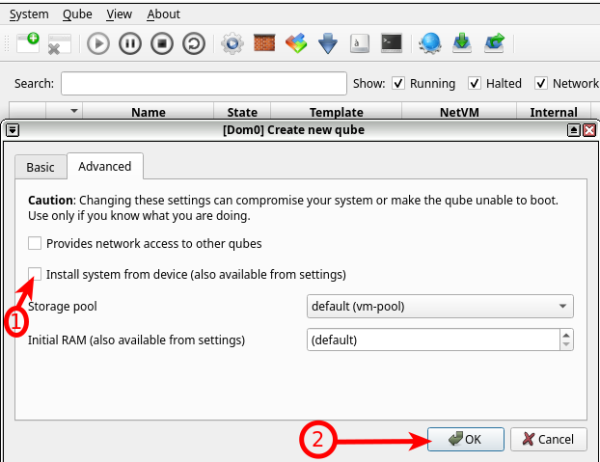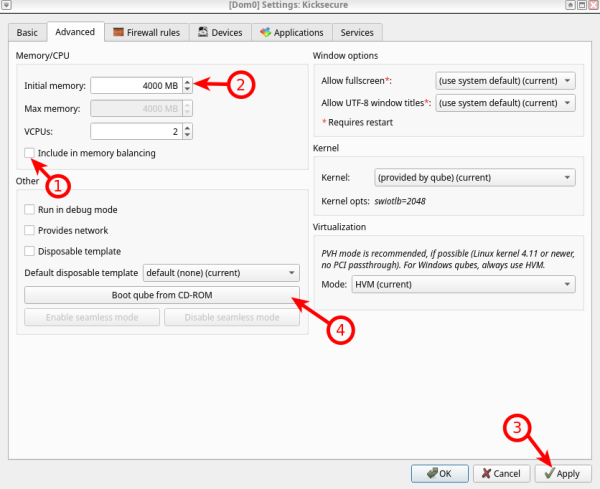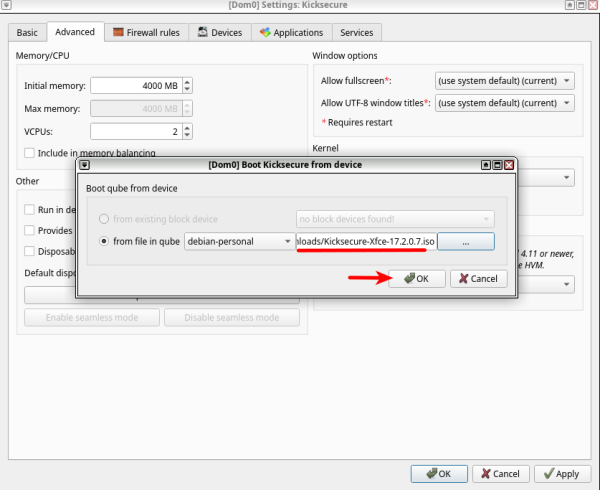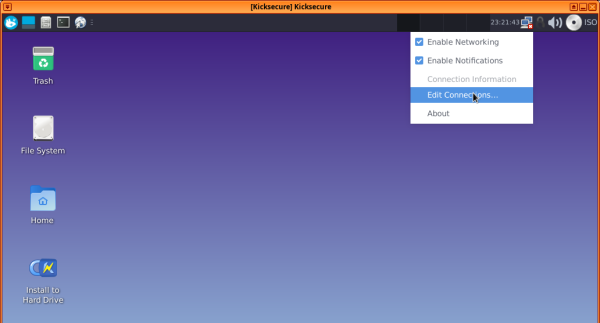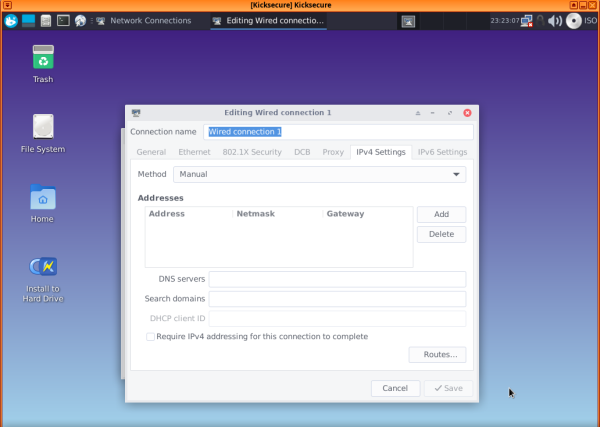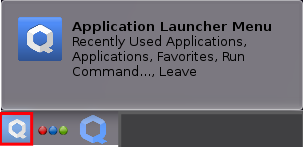Kicksecure for Qubes

Kicksecure for Qubes OS![]()
.
Installation
[edit]Select an installation method.
Template
This is the recommended way to install Kicksecure for Qubes.
Select your version of Qubes OS.
Qubes R4.2
Discouraged. Upgrading to Kicksecure 18 on Qubes R4.3 encouraged.![]()
In dom0.
qvm-template --enablerepo qubes-templates-community-testing install kicksecure-17
Done.
Template kicksecure-18 has been installed.
Qubes R4.3
In dom0.
Note: Command line parameter --enablerepo qubes-templates-community-testing can be removed as soon as the Template has been moved to the stable repository![]()
.
qvm-template --enablerepo qubes-templates-community-testing install kicksecure-18
Done.
Template kicksecure-18 has been installed.
Distribution Morphing
What is distro morphing? See Distribution Morphing.
Using the distro morphing is not the recommended way to install Kicksecure on Qubes.
Note: For Kicksecure version 18 (testers-only at the time of writing), Qubes R4.2 is unsupported. Only Qubes R4.3 can be used and Debian version 13 must be used as base distribution.
In dom0.
1. Install debian-13 as per the Qubes Debian Template documentation![]()
, which is unspecific to Kicksecure.
2. Clone Template debian-13 into Template kicksecure-18.
3. Start the kicksecure-18 Template.
Inside the kicksecure-18 Template.
1. Follow the instructions Install Kicksecure inside Debian, choose meta package kicksecure-qubes-cli or kicksecure-qubes-gui.
2. Shut down the Template.
3. Done.
Distribution morphing of Debian into Kicksecure is complete.
4. Change Template.
Optional: The user may change the Template for any App Qube from Debian to Kicksecure as per the usual Qubes way.
5. Create new App Qubes.
Optional: The user may create new App Qubes based on the kicksecure-18 Template as per the usual Qubes way.
HVM
Using the Kicksecure ISO is not the recommended way to install Kicksecure on Qubes.
If the user wishes to use the ISO for any reason (such as testing, development, comparison, or curiosity), the following steps apply (More details can be found in Qubes documentation![]()
.
Note: You need to perform downloading the Kicksecure ISO inside a separate App Qube that will be used to install Kicksecure from (in the example below, the ISO has been downloaded in "debian-personal").
1. Create a new App Qube, following the instructions in the image.
2. Remove "Install system from device" because we want to modify the VM before installing Kicksecure on it, then press "OK" to create the Kicksecure App Qube.
3. Enter the Kicksecure Qube settings.
4. Preferably, change system storage to 20 GB, then press "Advanced".
5. Disable "Include in memory balancing", then increase "Initial memory" to preferably 4 GB. Press "Apply" to adjust the edited settings, then press "Boot qube from CD-ROM" to choose the Kicksecure ISO.
6. Choose the App Qube where you have downloaded the Kicksecure ISO, then press "..." to browse for the ISO path.
7. Choose the Kicksecure ISO.
8. Make sure everything is correctly chosen, then press "OK".
9. Kicksecure is booted and ready to be installed. Kicksecure supports offline installation, so there is no need for network configuration before installation.
10. Done
HVM - Networking
If you want to use the internet before or after installation, you need to go through the following steps:
1. Right-click on the Network Manager taskbar icon, then choose "Edit connections..."
2. Choose "Wired connection 1", then press the settings (gear) icon.
3. Choose "IPv4 settings", then under "Method", select "Manual", and press "Add".
4. Fill in the blanks with the Net qube info, except for the subnet mask, which should be set as 255.255.255.0 instead of 255 at the end [2]. If the network still does not work, try changing the gateway to 10.137.0.1 [3].
5. After filling in the blanks, press "Save." The Network Manager gear should update itself with the newly added information.
6. Note.
6. Done.
7. Troubleshooting.
If networking is only working in either the user session or sysmaint session, and is not functional in the other session, you may have unintentionally disabled the "All users may connect to this network" setting. To fix this:
1. Boot into whichever session has working networking.
2. Right-click on the Network Manager taskbar icon, then choose "Edit connections..."
3. Choose "Wired connection 1", then press the settings (gear) icon.
4. Choose "General", then ensure "All users may connect to this network" is checked.
5. Press "Save".
6. Done. Networking should now work in the previously broken session.
See also:
- Qubes HVM: How to auto detect the network settings (IP, gateway) from inside the VM?

- Qube (VM) Recovery.
HVM - Troubleshooting
Low RAM, CLI interface
If the user will see:
Figure: virtual console login screen
Then increase RAM according to the instructions in chapter #ISO to have the graphical entry.
Cloned HVM
Cloned HVM will not change its internal IP address automatically.
If the user wants to clone their HVM, they must change the internal IP address to match the newly created cloned HVM IP address. [4]
Support Status
[edit]How stable is this? It should be very stable. This is because Qubes-Whonix is based on Kicksecure.
The lead developer of Kicksecure is also a user of Qubes and uses Kicksecure in Qubes.
Service VMs
[edit]Kicksecure in Qubes service VMs such as sys-net, sys-firewall, and sys-usb are functional. This is classified as unsupported to avoid complex support requests for issues not caused by Kicksecure being directed at Kicksecure support. [5]
sys-net: Increase of initial RAM to 800 MB might be required.
If using in-VM kernel:
it's problematic for VMs with PCI devices (especially when using Debian kernel, due to old wifi drivers, but there are also other factors like significantly slower boot time in HVM mode).https://github.com/QubesOS/qubes-issues/issues/9570#issuecomment-2468812870
ClockVM
[edit]A ClockVM based on the Kicksecure Template is functional out of the box.
The only requirement is that the ClockVM uses Kicksecure as its Template. For example, if using Qubes' default settings, where ClockVM is set to sys-net by default and sys-net has been configured by the user to use the kicksecure-18 Template, then ClockVM will be functional out of the box and use sdwdate for clock synchronization. See also sdwdate chapter, Qubes Specific.
Choose graphical user interface (GUI) or command line interface (CLI).
Sample setting:
sys-net
3. Optional: Change ClockVM to a different App Qube.
4. Ensure that the ClockVM has its Template set to kicksecure-18.
5. Done.
The process of using Kicksecure as ClockVM has been completed.
Qubes Persistence
[edit]Qubes (non-)persistence is a Qubes default and unspecific to Kicksecure.
| Inheritance [6] | Persistence [7] | |
|---|---|---|
| Template |
n/a | Everything |
| App Qubes |
/etc/skel/ to /home/
|
/rw/ (includes /home/ and bind-dirs |
| Disposable Template |
/etc/skel/ to /home/
|
/rw/ (includes /home/, /usr/local and bind-dirs |
| Disposable |
/rw/ (includes /home/, /usr/local and bind-dirs |
Nothing |
Qubes Template Modifications
[edit]If a Qubes Template has been modified, to make changes in App Qubes based on that Template take effect, it is required to shut down the Template and restart the App Qubes based on that Template. This is a Qubes default and unspecific to Kicksecure.
To apply changes made to a Template:
1. Make the required modification to the Template.
2. Shut down the Template.
3. Shut down the App Qube based on the modified Template.
4. Start the App Qube based on the modified Template.
5. Done.
These steps ensure that all changes made to the Template are properly propagated to the App Qubes.
Known Issues
[edit]- Qubes has potential local privilege escalation issue: harden insecure permissions inside
/dev/xenfolder / research security impact of the Qubes/dev/xenfolder permissions #9717
-- This issue is unspecific to Kicksecure and is entirely unrelated to Kicksecure. It equally applies to App Qubes that are not using
qubes-core-agent-passwordless-rootsuch as Qubes Debian minimal Template. - On Qubes OS R4.3, it is possible a deluge of notifications will appear any time a Kicksecure 18 template or AppVM is running. These notifications will say
Denied: sdwdate-gui.ConnectCheck. This will result ifqubes-core-admin-addon-kicksecureis not installed and set up in dom0. If this occurs:
1. In dom0, run the following commands (from the R4.3 installation instructions above):
sudo qubes-dom0-update --action=install qubes-core-admin-addon-kicksecure
sudo systemctl restart qubesd.service
2. Launch Qterminal in the kicksecure-18 template.
3. In the terminal, run bash. The default shell (zsh) will not work here.
4. Once a Bash prompt appears, run:
cd /etc/qubes/post-install.d || exit 1 for i in *.sh; do source "$i"; done
5. Shut down the kicksecure-18 template and all AppVMs based on it.
6. In dom0, run:
qvm-features kicksecure-18 | grep '^kicksecure'
7. Verify that you see a line that looks like kicksecure 1.
8. Done.
The process of installing and setting up qubes-core-admin-addon-kicksecure is complete.
Developer Information
[edit]Information for developers:
qubes-template-kicksecure
source code
- Qubes GitHub feature request: build Kicksecure Qubes Template #9573

- Kicksecure-Qubes development wiki page
- Kicksecure-Qubes Template development forum discussion

- Please contribute to Kicksecure and Qubes OS by creating and maintaining a
kicksecure-18Qubes Template.
Footnotes
[edit]qubes-core-admin-addon-kicksecure
- ↑
qubes-core-admin-addon-kicksecure:
Note: Running this command will not be necessary in R4.3 final release. This is only necessary if using a Qubes R4.3 installation from an earlier testing or release candidate ISO. sudo qubes-dom0-update --action=install qubes-core-admin-addon-kicksecure sudo systemctl restart qubesd.service - ↑
https://github.com/QubesOS/qubes-issues/issues/4189#issuecomment-515803005

- ↑
https://github.com/QubesOS/qubes-issues/issues/7412

- ↑
https://github.com/QubesOS/qubes-issues/issues/7845

- ↑
https://forums.kicksecure.com/t/kicksecure-for-sys-qubes-and-sys-vpn/442

- ↑ Upon creation.
- ↑ Following shutdown.
- ↑ https://www.qubes-os.org/doc/templates/

- ↑ The former name was Template.
- ↑ The former name was AppVM or TemplateBasedVM.
- ↑ https://github.com/QubesOS/qubes-issues/issues/4175

- ↑ Former names included Disposables Template, DVM Template, and DVM.
- ↑ https://www.qubes-os.org/doc/glossary/#disposable

- ↑ Former names included Disposables and DispVM.

We believe security software like Kicksecure needs to remain Open Source and independent. Would you help sustain and grow the project? Learn more about our 13 year success story and maybe DONATE!


